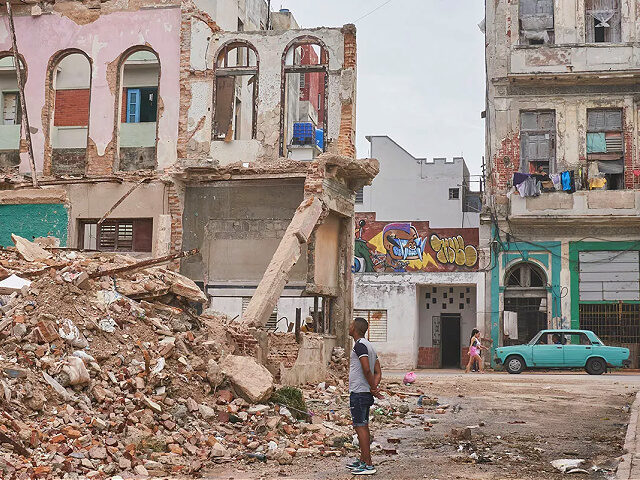Five Cuban families residing in a crumbling building in Old Havana sent a letter to the news website Cibercuba expressing fear that their derelict building, which suffered a partial collapse in October that claimed the life of a five-year-old, will face another collapse that will end their lives.
The communist Castro regime’s lack of investment in improving the living conditions of its citizens over its more than six decades in power has left the nation’s historic buildings and households in a most precarious state. The regime regularly ignores the pleas of citizens who live in these high-risk buildings, rejecting requests to address and repair structural damage.
In the harrowing missive, the Cubans living in the partially collapsed building on Old Havana’s Sol Street said they have spent the past three months presenting their urgent case to all the responsible authorities and agencies without any sort of response.
Their building suffered a partial collapse on October 17. The old building’s roof fell down, trapping two women and a child, five-year-old girl Ismary Orozco Castellanos, who died in the incident.
“The remaining neighbors of the building located in Sol street, between Egido and Villegas, continue to live in the building, where pieces of the building’s wall and roof continue to fall daily,” the letter explained. “We have gone to municipal housing, provincial and municipal government, to the attorney general of the Republic, to the National Assembly, to the provincial [Communist] Party and they do not give us an answer, so we continue to be exposed to dying in another collapse.”
“We have not gone [just] once – we go every two or three days to these entities where they already know us for making complaints and they do not solve anything for us,” the letter continued. “We have our things there, that we can lose as well as our lives, and when we arrive at these places they tell us ‘you again?’ as if we were the plague.”
Prior to the October collapse, the same building experienced a similar partial collapse in 2015. According to an interview with a resident at the time, the Castro regime did not remove the collapsed debris, which caused the building’s stairs to also collapse as a result — forcing the residents of the building to enter and exit the edifice through a window.
The five families continued their letter by lamenting the lack of any solution from the Communist Party and detailing the case of an 86-year-old woman in the building’s 12th apartment. The woman, who had open heart surgery, suffers from a wide array of medical conditions according to the letter, such as diabetes, high blood pressure, deafness in one ear, and swollen legs. The stress caused by the dangerous conditions of the building further worsens her condition, they write.
“She can’t sleep well from thinking about how she lives, that a piece [of the building] may fall into her house,” the writers noted.
Referring to the collapse in October, the letter writers note that one of the women injured should remain hospitalized, but was expelled from the hospital because they needed her cot.
“Said lady has nowhere to live, in addition to the fact that she lost everything. And according to our Party, she told her and other neighbors that we were not going to be destitute, so yes we are helpless,” they wrote.
Their building is enduring an increasingly common situation in the Cuban capital. In May, 45 Cuban citizens died due to a gas explosion in Havana’s Hotel Saratoga. The explosion not just severely damaged the infrastructure of the historic hotel, but also caused damage to the surrounding residential buildings, leaving the inhabitants in a constant state of fear that their now-damaged households can collapse at any moment.
In November, less than a month after the collapse that killed the five-year-old girl, another building in Havana suffered a partial collapse. Fortunately, no grave injuries or deaths were reported.
In December, one month later, the balcony of a building in Havana collapsed with no reported injuries. One year prior, on December 2021, the wall of a building in Old Havana collapsed, trapping two passersby and killing one of them. A 26-year-old man died in 2020 after a building in Old Havana collapsed.
The precarious state of Cuba’s infrastructure is also not limited to residential buildings. On January 06, the collapse of a mural in the municipality of Sancti Spíritus left three young Cuban students with severe injuries. The students were reportedly waiting for the “Caravan of Liberty,” a celebration of the communist regime that recreates Fidel Castro’s entry to Havana in 1959.
The letter sent to Cibercuba concludes by stating that January 17, 2023, will mark their third month since the building partially collapsed in October.
Cuba under communism has invested little in residential communities, opting instead to focus investment on the nation’s luxury hotels and tourist venues that are out of reach for the overwhelming majority of the impoverished citizens. The luxury vacation facilities often attract celebrities who enjoy these amenities while turning a blind eye to the reality of communist Cuba’s inhumane living conditions.
By July 2022, Cuba had received over 682,000 international tourists, according to the Castro regime, allowing it to take in $1.1 billion in revenue from tourism.
Christian K. Caruzo is a Venezuelan writer and documents life under socialism. You can follow him on Twitter here.

COMMENTS
Please let us know if you're having issues with commenting.